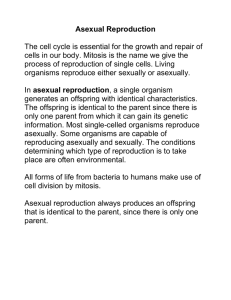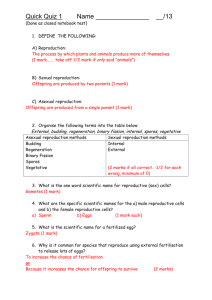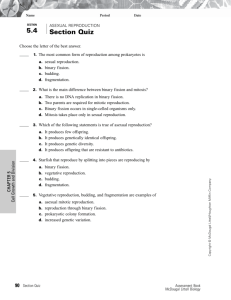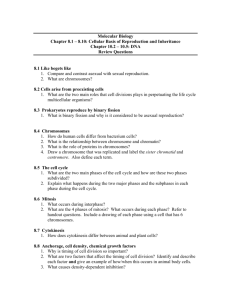5.4 Asexual Reproduction
advertisement
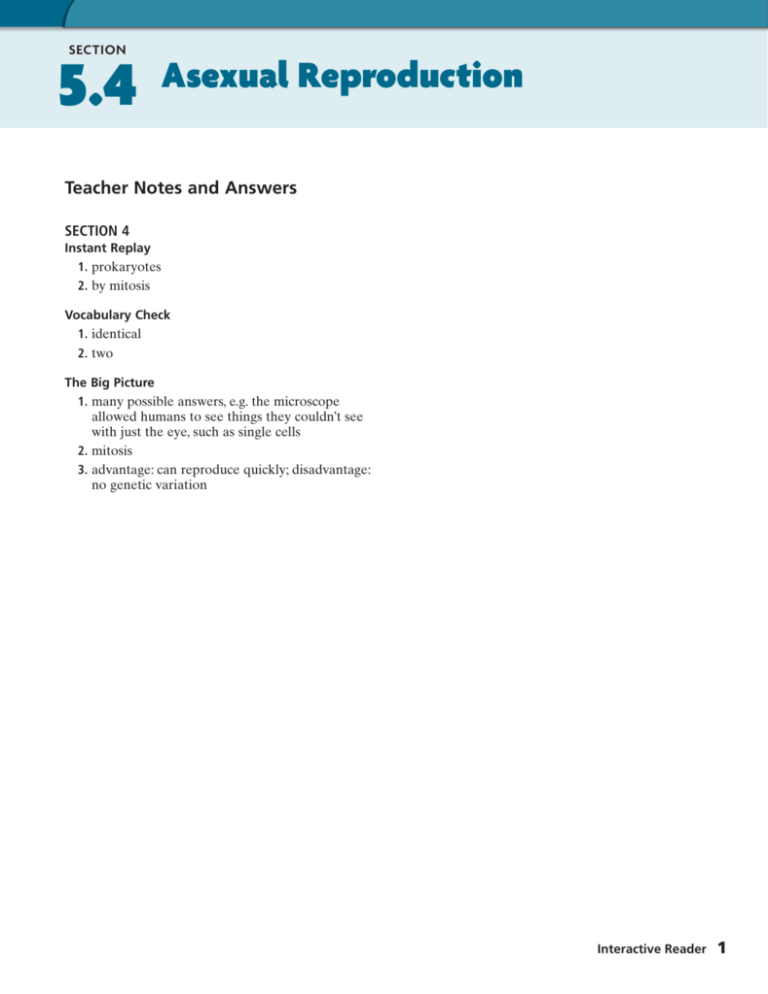
section 5.4 Asexual Reproduction Teacher Notes and Answers SECTION 4 Instant Replay 1.prokaryotes 2.by mitosis Vocabulary Check 1.identical 2.two The Big Picture 1.many possible answers, e.g. the microscope allowed humans to see things they couldn’t see with just the eye, such as single cells 2.mitosis 3.advantage: can reproduce quickly; disadvantage: no genetic variation Interactive Reader 1 section 5.4 Asexual Reproduction KEY CONCEPT Many organisms reproduce by cell division. Binary fission is similar in function to mitosis. Reproduction is a process of making new organisms from one or more parent organisms. It happens in two ways, sexually and asexually. Sexual reproduction involves the joining of egg and sperm, and results in unique* offspring. Asexual reproduction is the production of offspring from a single parent. The offspring are, for the most part, genetically identical to each other and to the parent. VISUAL VOCAB Binary fission is the asexual reproduction of a single-celled organism by division into two roughly equal parts. Binary means “in parts of two.” Fission means “dividing” or “separating.” parent cell DNA duplicates Binary Fission and Mitosis Recall that prokaryotes include organisms such as bacteria. Most prokaryotes reproduce through binary fission. Binary fission (BY-nuh-ree FIHSH-uhn) is asexual reproduction of a single-celled organism by division into two parts. Binary fission does not follow the same steps as mitosis; the processes are different. But binary fission and mitosis have similar results—two daughter cells that are genetically identical to the parent cell. cell begins to divide daughter cells Bacteria Growth 1200 Advantages of Asexual Reproduction Asexual reproduction can quickly result in large numbers of offspring. All cells can have offspring. In contrast, sexual reproduction is slower. Only females can have offspring, and many sexually reproducing organisms must find a mate. Number of bacteria 1000 800 600 400 200 Disadvantages of Asexual Reproduction Asexually reproduced offspring are genetically identical— so they will respond to their environment in the same way. If conditions stay the same, this is not a problem. If the environment changes, and the organisms cannot live with the changes, the entire population could die off. In contrast, offspring from sexual reproduction are genetically different from the parents. Genetic diversity increases the chance that some individuals will survive even in changing conditions. What types of organisms reproduce by binary fission? * Academic Vocabulary unique unlike any other 2 McDougal Littell Biology 0 1 2 3 4 5 6 7 8 Cycles of cell division One bacterium can result in a total of 1024 cells after only 10 rounds of cell division. 9 10 Some eukaryotes reproduce through mitosis. Growing a new plant from a cutting is an example of asexual reproduction through mitosis. Sea stars, flatworms, strawberries, potatoes, sea anemones, yeast, and many other eukaryotic organisms can also reproduce asexually, through mitosis. Many organisms can reproduce both sexually and asexually. The form of reproduction may depend on the conditions around the organism. How do eukaryotes reproduce asexually? 5.4 Vocabulary Check asexual reproduction binary fission Circle the correct word to complete each sentence. Mark It Up Go back and highlight each sentence that has a vocabulary word in bold. 1. Asexual reproduction results in genetically different / identical daughter cells. 2. Binary fission is when a single-celled organism divides into two / four daughter cells. 5.4 The Big Picture 1. Through what process do most prokaryotes reproduce asexually? 2. Through what process do eukaryotes reproduce asexually? 3. List one advantage and one disadvantage of asexual reproduction. Interactive Reader 3


